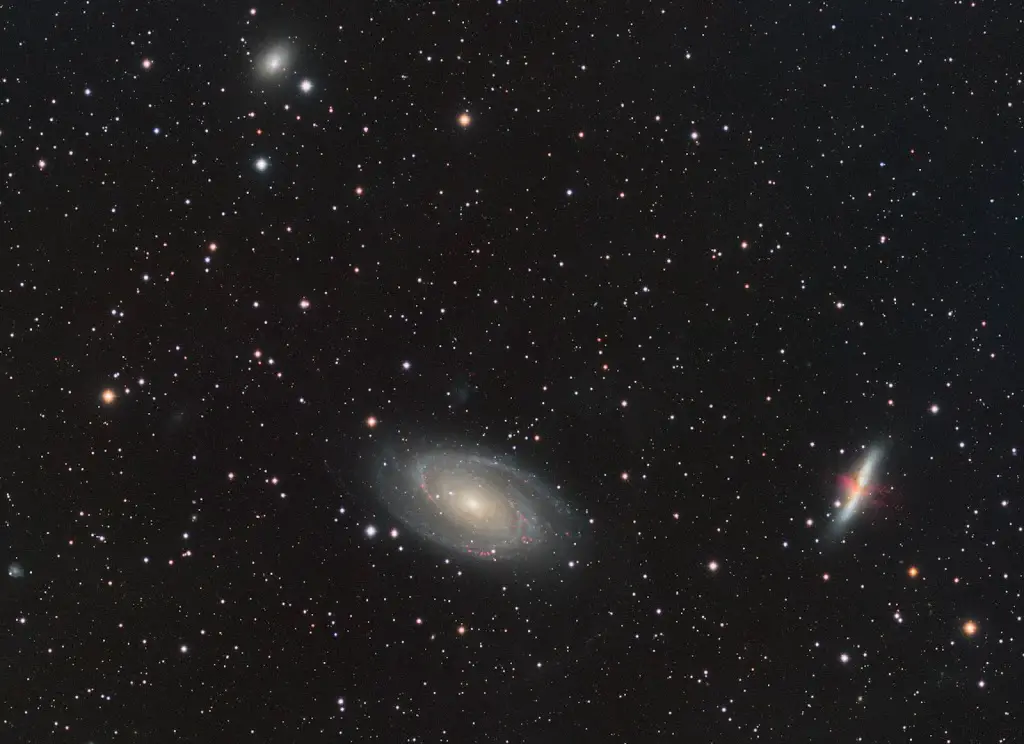Messier 82 (M82), also known as the Cigar galaxy is an edge-on starburst galaxy that formed by the interaction with the neighboring galaxy, Messier 81 (M81). Messier 82 was discovered by Charles Messier, who subsequently included the galaxy in his catalogue in the late 18th century. M82 belongs to the M81 Group of galaxies. It located 12 million light-years away which appears high in the northern spring sky in the direction of the constellation of Ursa Major. The Cigar owes its name to its long, narrow shape and possibly due to the fact that it appears ashy when observed through small telescopes. It is about five times more luminous than the Milky Way and has a center one hundred times more luminous making the galaxy itself bright enough to be seen in binoculars.
In the late 1700s, French astronomer Charles Messier compiled a list of celestial objects that he thought might be mistaken for comets because they appeared fuzzy and nebulous when viewed through telescopes of the time. On this list was M82, an irregular galaxy located 12 million light years away in the constellation Ursa Major (the Great Bear). At first glance, astronomers thought that the Cigar galaxy looked exactly like its name implies, with swirling clouds of gas and dust creating a fuzzy halo around its bright center and long arms reaching outward like giant bat wings.
The Cigar galaxy is a site of intense starburst activity where lots of young massive star are being born 10 times faster at a higher average rate compare to our entire milky way galaxy. Young stars are packed together into tiny but massive star clusters. With dozens of these, it creates bright patches, or “starburst clumps” in the central part of M82. While for most of the pale, white objects sprinkled around the body of M82 that look like fuzzy stars are actually an individual star clusters containing up to a million of stars. The active star forming region in the center spans about 500 parsecs in diameter.
With smaller size and a lot of energy concentrated in the center of the core of the galaxy, it is much more efficient process contrast to the milky way where all the massive stars are mostly in the outer spiral arms of the disc. Those stars cluster are so confined in the nucleus, it takes up the fuel of the galaxy giving them strong explosive energy. Explosive stars produced massive wind results in pushing material out of the galaxy that we perceived as galactic super wind or chimney through both side of its disc. However, New research shows that magnetic fields are also contributing to the expulsion of material from M82.
As SOFIA, a joint project of NASA and the German Aerospace Center, DLR, previously found using the instrumented called the High-Resolution Airborne Wideband Camera, or HAWC+, the wind drags the magnetic field near the galaxy’s core so that it’s perpendicular to the plane of the galaxy across 2,000 light-years. Researchers wanted to learn if the magnetic field lines would extend indefinitely into intergalactic space like the magnetic environment in the solar wind, or turn over to form structures similar coronal loops founded in active regions of the Sun. They calculate that the galaxy’s magnetic fields extend out like the solar wind, allowing the material blown by the super wind to escape into intergalactic space.
“The magnetic fields may be acting like a highway, creating lanes for galactic material to spread far and wide into intergalactic space,” said Jordan Guerra Aguilera, a postdoctoral researcher at Villanova University in Pennsylvania. From the Hubble Space Telescope and the Spitzer Space Telescope, Magnetic fields in M82 are shown as lines over a visible light and infrared composite image of the galaxy.
![]()
